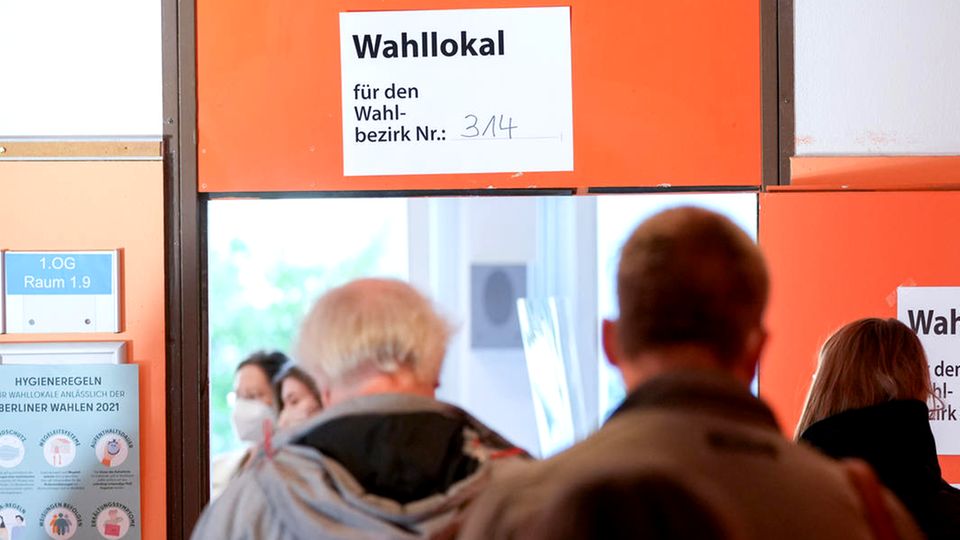The Greens and the FDP decide who to make Federal Chancellor. Therefore, the two want to negotiate with each other first. That should be difficult enough, because there are fundamental differences in economic policy and taxes.
The result of the federal election leads to an extraordinary situation: Both the victorious Social Democrats under Olaf Scholz and the second-placed Union with Armin Laschet want to lead the next federal government. And both want – in the absence of alternatives – to govern with the Greens and the FDP. So it is up to the two smaller parties who they make the next Federal Chancellor.
And they are now turning the tables: on the evening of the election, the leaders of the liberals and the Greens made it clear that they are not waiting for invitations to meet the potential chancellor parties, but want to talk to each other first about how to get together in terms of content. A kind of exploratory talks between the Chancellor-makers.
Why not? The two parties traditionally face each other in the left and the bourgeois camp, but there is also something that connects them. Both parties are liberal on social issues, they tend to appeal to young voters, they want a modernization of the state after long Groko years. And they have formulated the clear will to step out of the opposition role and to come together for a common government.
Nevertheless, the green-yellow conversations are likely to be difficult, because there are a few things that separate them. Especially in central points of economic and tax policy, the FDP and the Greens have completely different ideas. Those are the biggest sticking points.
Reconstruction of the economy
The fact that the Greens and the FDP can find common ground at all is because their respective hobby-horses, economic development and climate protection, are no longer seen as opposites as they used to be, but as a necessary symbiosis. The German economy must become climate neutral, that was decided long ago. In principle, the Greens and the FDP agree that the CO2 price must act as a central element of control.
However, the Greens want the price of CO2 on fossil fuels to rise significantly faster than previously planned. It is expected to rise to 60 euros per ton as early as 2023. According to the plans of the current government, it will only increase from 25 to 35 euros by then. The FDP also sees trading in CO2 certificates as a central control instrument, wants to expand it and make the certificates more expensive. However, the liberals remain vague about the level of the targeted CO2 price.
A higher CO2 price makes driving and heating more expensive for many consumers. The Greens therefore want to repay the income from the CO price to the citizens in the form of “energy money”. This should relieve the burden on low-income earners and families in particular. The FDP would also like to repay the income from the CO2 price to the citizens in the form of a “climate dividend”.

Differences in climate protection
At first it sounds like you could come together in climate policy with a bit of haggling over the CO2 price, but in practice there are numerous stumbling blocks. The Greens want to move forward the coal phase-out from 2038 to 2030, the FDP does not want that. The Greens want a speed limit and no more combustion engines from 2030. The FDP does not want a speed limit and wants to keep the combustion engine running on synthetic fuels. The Greens have many specific climate protection plans in their program, such as compulsory solar power on new house roofs, the FDP wants to set as few fixed specifications as possible.
The bottom line is that a study by the German Institute for Economic Research (DIW) comes to the conclusion that the Greens and FDP are the furthest apart from each other when it comes to climate policy. While the Greens’ program, according to DIW, is most likely to comply with the goals of the Climate Protection Act, the FDP program is the least suitable in this regard.
Taxes and finances – nothing fits
There are also huge differences between green and yellow when it comes to taxes and finances. The Greens want to relieve small and medium incomes and increase the top tax rate for high earners. The FDP, on the other hand, does not want the top tax rate to be increased and also demands that it only apply from an annual income of 90,000 euros. The Greens are demanding a wealth tax of one percent on assets of more than two million euros, the FDP rejects a wealth tax. The Liberals do not want a higher inheritance tax either.
In addition, the FDP also wants to give the economy massive tax relief. The corporate tax burden is to be reduced to 25 percent, and the trade tax will be completely eliminated. The liberal tax reduction program fundamentally collides with the Greens’ plans for more government spending to transform the state and economy in a way that is climate-friendly. The Greens also want to change the debt brake so that the state can finance annual investments of 50 billion euros through loans. The FDP wants to keep the debt brake in its current form.
How central the conflict is when it comes to financial issues can also be seen from the fact that FDP leader Christian Lindner has been aggressively calling for the Ministry of Finance for months, while the Greens co-party leader Robert Habeck has been squinting at the office. The green-yellow talks should therefore be challenging – and then you have to agree on a suitable chancellor party.
Jane Stock is a technology author, who has written for 24 Hours World. She writes about the latest in technology news and trends, and is always on the lookout for new and innovative ways to improve his audience’s experience.




